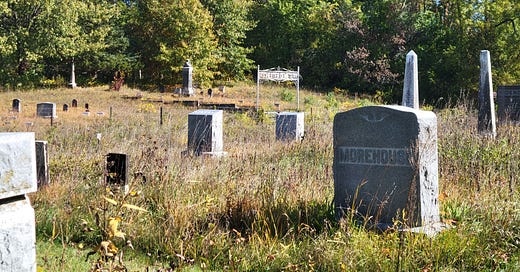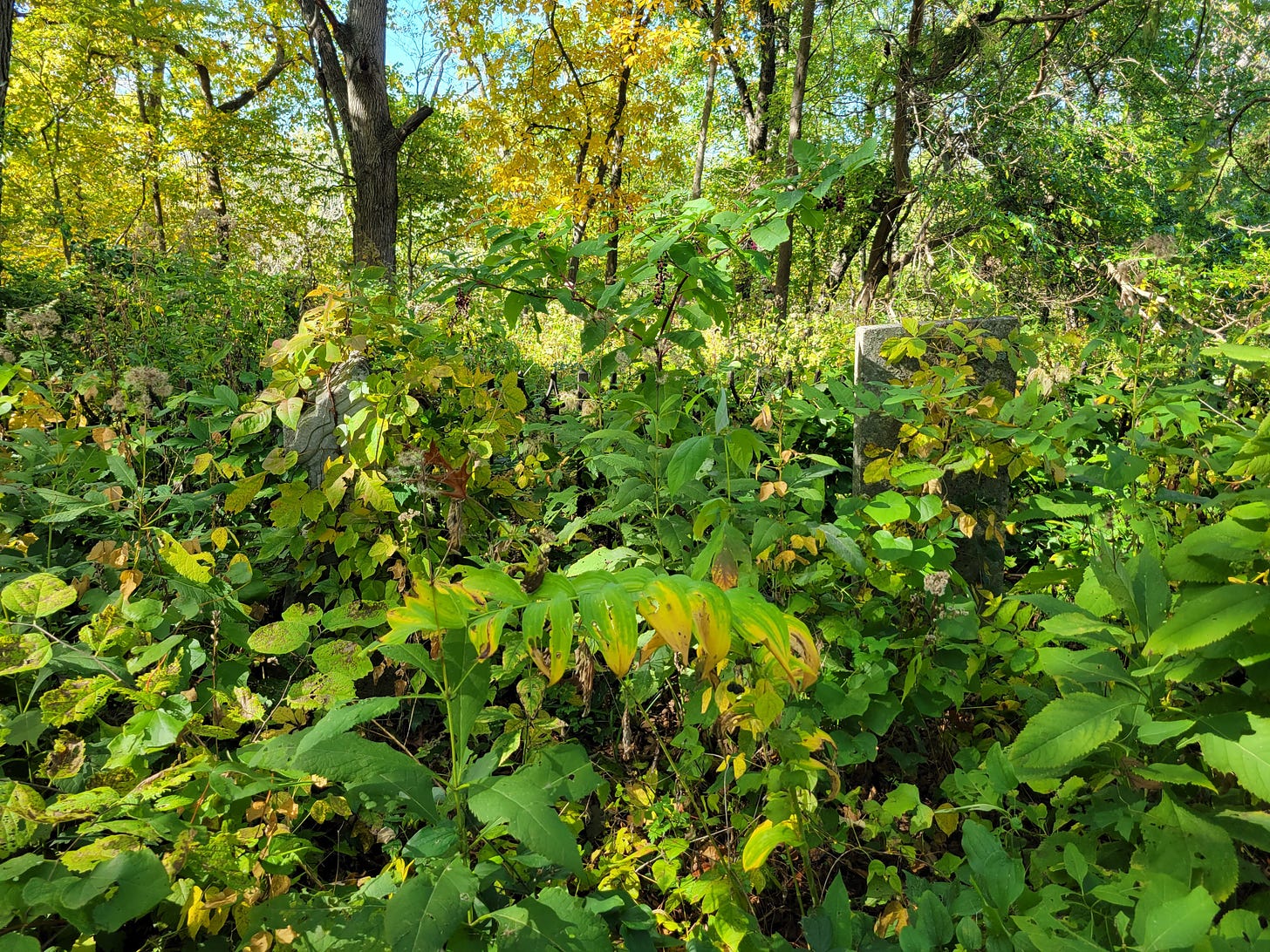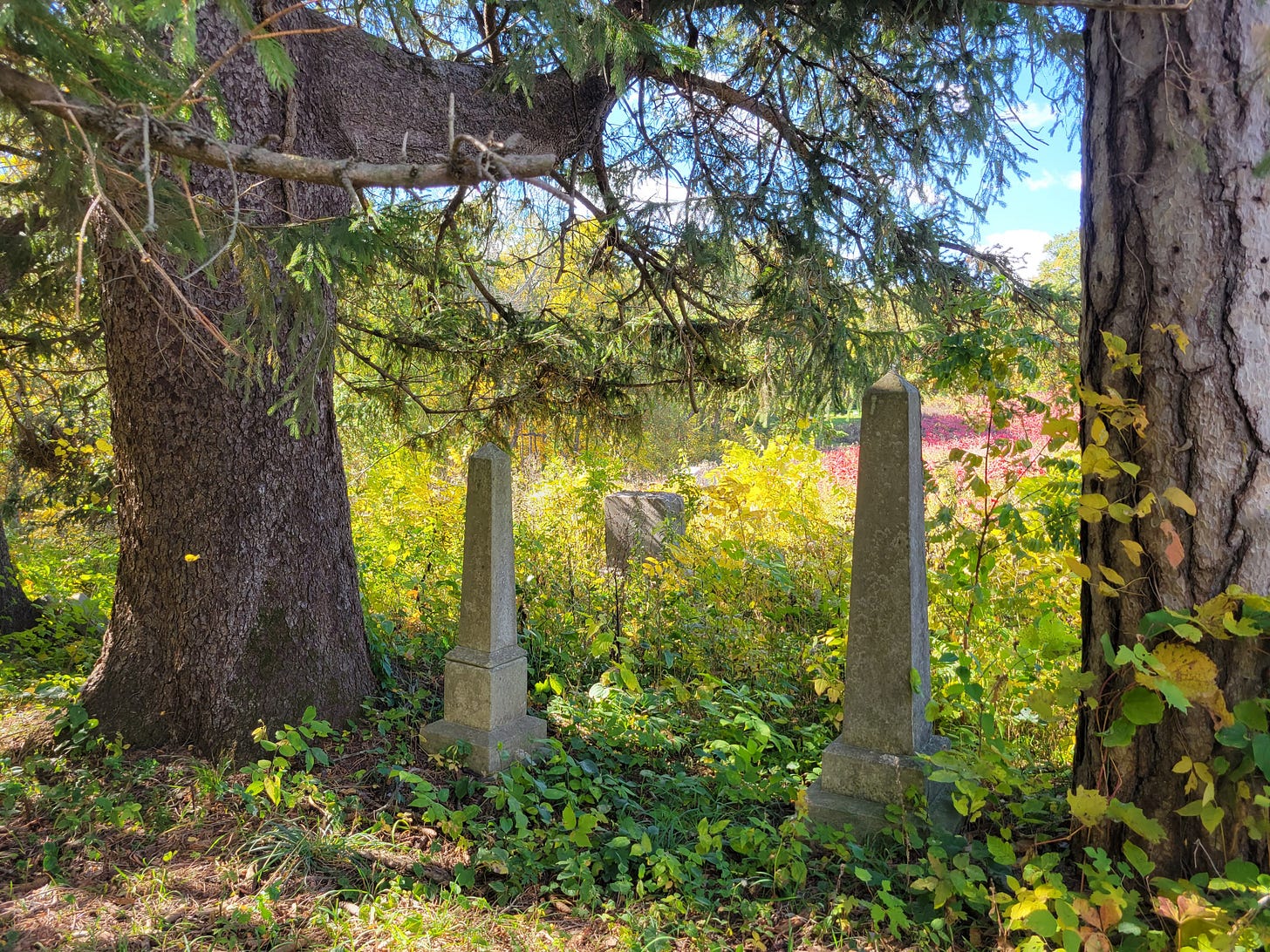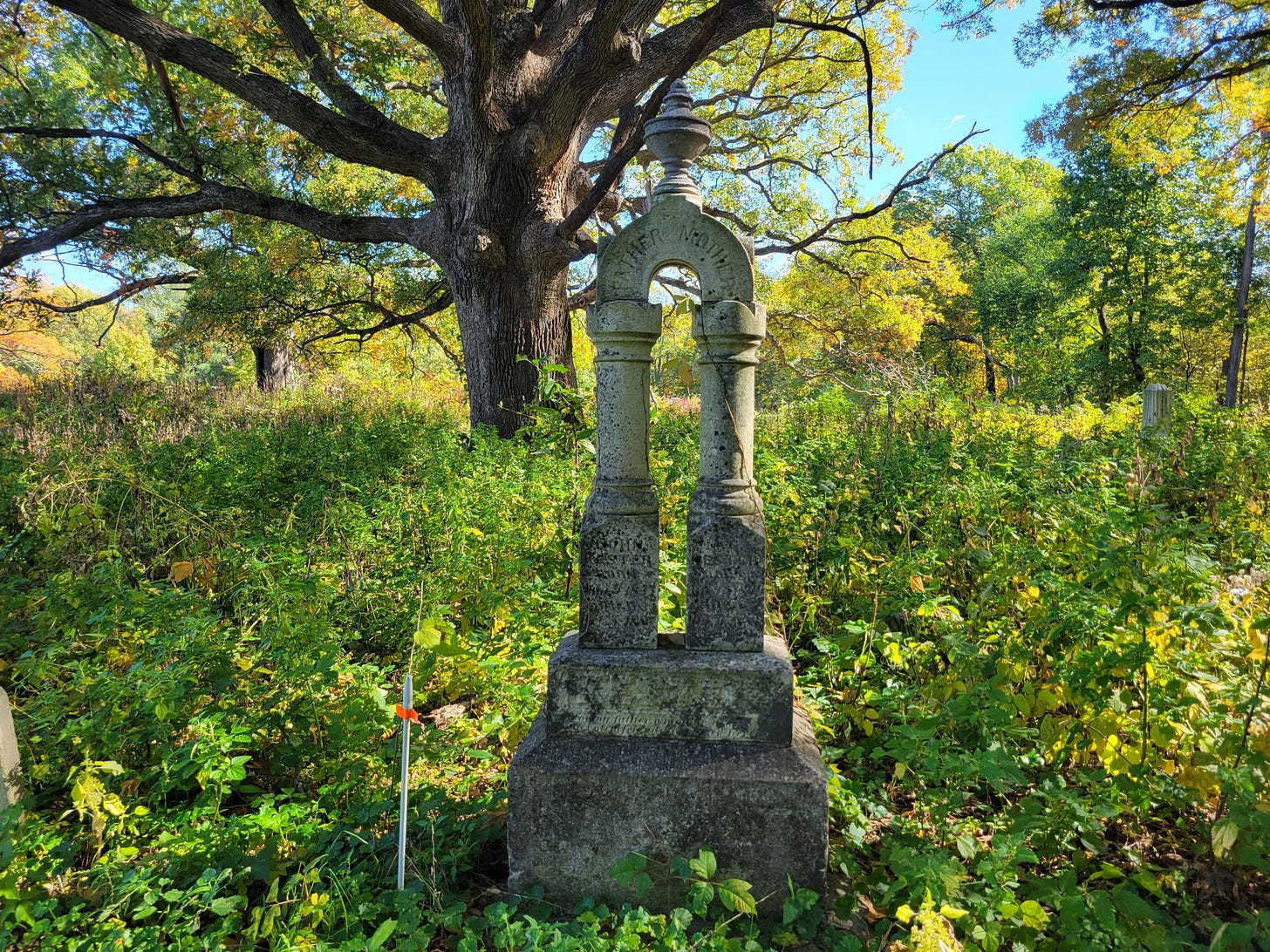A Dispatch from Rochester Cemetery
It was one of those days at the height of fall where the clothing that kept you cozy in the crisp morning renders you slightly overheated in the afternoon. The dust trailed behind me as my Google Maps chirped, leading me down a shady gravel road. Eventually, the canopy opens up, and I see a white iron gate with the words ‘Rochester Cemetary’ written across the top in a bold, vaguely gothic font.
A Refuge on the Landscape
I’ve talked several times on this blog about how Iowa is one of the most modified landscapes in the world. After decades of converting the prairie to farmland, there are few landscapes untouched by colonization. If you’ve visited a prairie in the state, odds are it’s a restored prairie. An important effort, but not something that can give you the full picture of what once was. For that, you need a remnant.
Remnant prairies are difficult to find in the state. It was the deep sod of the tallgrass that attracted farmers to the region, and they would take advantage of every square foot of rich cropland they could. Finding land that wasn’t tilled or used in some other fashion at some point is a tall order. However, one of the best sources of remnant prairie can be found in pioneer cemeteries.
Early settlers in the region established small cemeteries near their farms in the countryside. The earliest of these plots were placed directly in the prairie. Because of this, that land was never tilled, creating an ecological time capsule protected by our taboos around disturbing the dead. If you want to explore the landscape as it existed prior to settlement, these cemeteries are one of the best places to do so.
That is what brought me to Rochester Cemetery in Cedar County, Iowa.
This site is well-known for being one of the most picturesque remnant prairies in the state. Guarded by ancient white oaks, grasses and forbs blanket the cemetery. The site is a mecca for wildflower enthusiasts in the spring, who come to picnic in the flowing grasses and photograph the popping purples, blues, yellows, and reds of the bloom. Professionals are also attracted to the site, collecting seeds to use in prairie restorations in central Eastern Iowa. Since prairie seeds are adapted to local climate and ecological conditions, sourcing seeds locally is paramount for a successful restoration. Remnant prairies also have twice the biodiversity of restored prairies, so ecologists wishing to capture even the faintest of pictures of interactions between species in an eastern tallgrass savanna would find this cemetery a veritable library of Alexandria. Of the 350 species represented at Rochester, there are innumerable opportunities for study and observation.
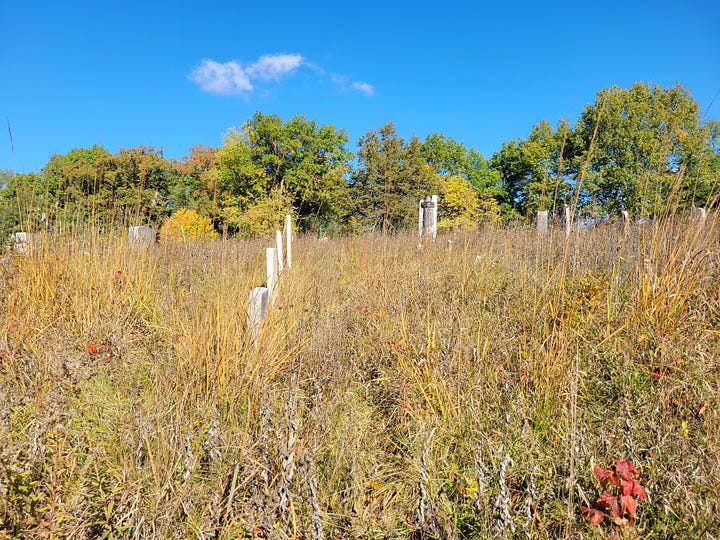
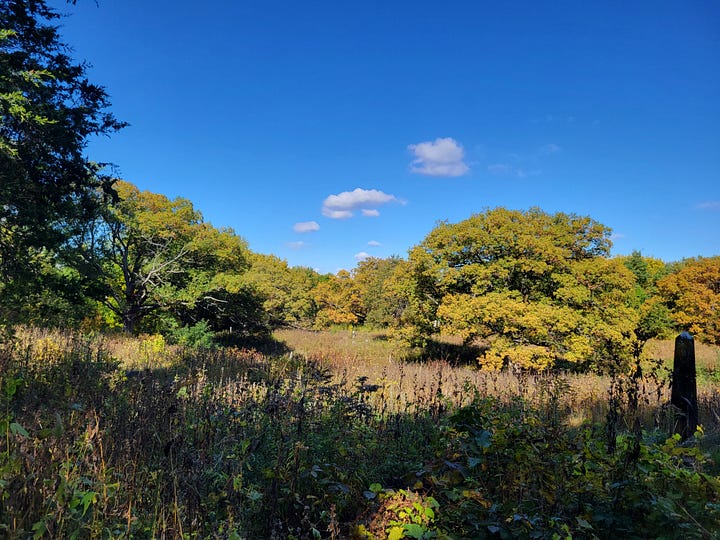
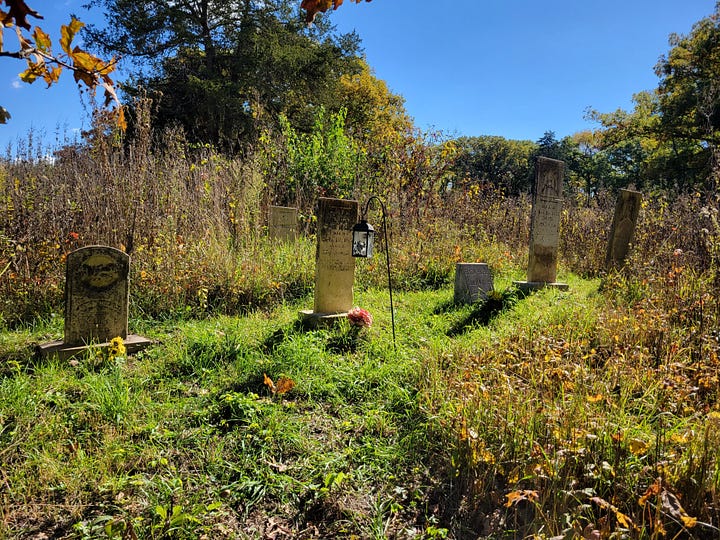
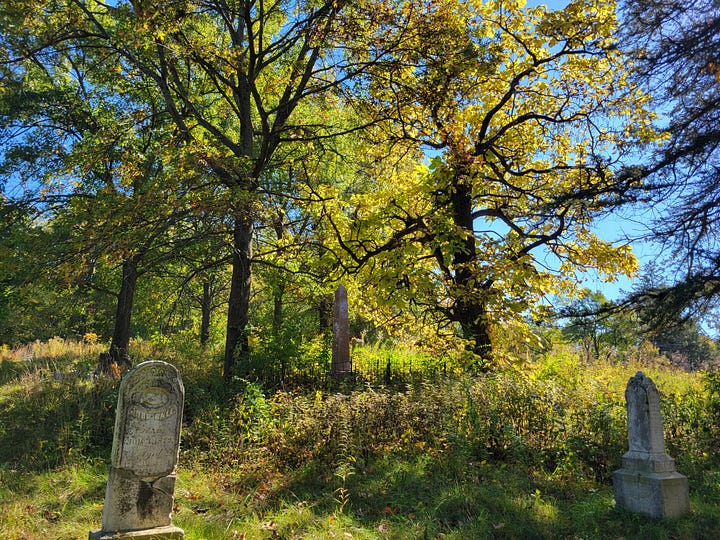
I, of course, visited the cemetery in the fall. Despite missing the spectacular flower show, I was greeted by the beauty of an end-of-season senescence. A melange of yellows and oranges, with the greens becoming ever weaker as the days trot on. A similar story can be seen in the understory, as dormancy takes hold and the last seed heads of the season are bursting onto the scene. A scene of decay appropriate to the setting.
To see more of the prairie during wildflower season, check out this clip from Iowa Outdoors.
A flashpoint of priorities
As can be seen in the pictures above, the cemetery and the prairie are one and the same on this site. Grasses grow wild throughout most of the area, with trail-like pathways guiding one through to the grave markers. Up around the savanna, many markers are nestled among the trees that have grown up since their burial. Markers are sometimes organized in something resembling a row, but there are spots where they are laid out in a much more chaotic fashion.
This is in stark contrast to the organization of most cemeteries. Traditionally, burial plots are laid out in neat and orderly rows, and the grass is mown regularly on a flat and level field. The few trees that are allowed are kept in tight control so as not to encroach among our resting dead.
As you can imagine, this state of affairs has caused some conflict among the local community as to how the cemetery should be managed, with the occasional ecologist or prairie enthusiast entering the fray. Rochester is a public cemetery administered by the local township, and any resident has the right to be buried on the site. Many locals have relatives buried here, from great-great-grandparents to spouses and siblings.
The primary controversy is whether to mow the cemetery and how often. The Board of Trustees currently conducts a rough mow once or twice a year. Ecologists actually note that this management strategy vaguely approximates the natural disturbances of grazing and fire that are currently absent from the prairie, which somewhat helps to control invasives and promote a healthier ecosystem.
In 2006, the Rochester township was embroiled in a controversy over the management of the cemetery. A petition was circulated among the community to have the entire cemetery mowed and managed more like a traditional cemetery. Community members rallied against out-of-towners, saying their family’s final resting place isn’t a wildflower bed for their recreational enjoyment or scientific investigations. The mowing issue was front and center at the next election. And even though the pro-mow crowd lost the election, its sentiment is still strong within the community.
Walking through the cemetery, I could definitely sympathize with those who favor mowing, even if I don’t agree. There was one family plot that was absolutely covered in grasses and vines. The gravestones were barely visible under the dense foliage. I do feel a twinge of sadness at the thought of someone’s eternal resting place being so obscured.
As of now, plots are mowed annually, and families are allowed to mow their own plots on their own. However, most of the cemetery is still in its natural growth pattern.
Death and Monoculture
A tension within this cemetery, both in the physical space and the philosophy of our management, is between competing against vs. embracing the forces of nature.
Death is a process that is deeply tied to the natural world. When a plant or animal dies, the chemicals of life are released from their duty of sustaining the organism and flow into the ecosystem. The movement of these nutrients is essential for the continuation of life. The organisms that facilitate this process, the bacteria and fungi and scavengers that reuse the substances that once sustained us release those nutrients for use once again. So, the circle of life can keep on spinning.
In many human cultures, we have decided to fight this process. This is not a critique. Ceremony, ritual, and preservation are essential cultural institutions. They help those who are left to make sense and come to peace with their loss, and they help families and communities to connect with their ancestors. To aid in this process, complex systems of burial and remembrance have been developed, including those that preserve the body and seek to establish a permanent monument to their life.
Decay reminds us of our own mortality, and thus we have developed strong taboos around how we manage places of death. Overgrown cemeteries, weathered grave markers, and haphazard rows are all major signs of disrespect towards the dead, in part because we have conceptualized them as indicative of decay. Of having been forgotten to rot in the ground. Violating these taboos caused such a strong fight among the Board of Trustees.
One scene that captured me was two grave markers nestled in between a pine and a fir tree. The markers were clearly quite old, lichen-covered pillars with an illegible inscription. From the look of it, those markers were staked prior to the planting of the trees. As the conifers grew, they drew sustenance from the two individuals buried there. Two individuals whose names, once literally etched in stone, are lost to time. But they live on in these two trees, which bring habitat for the birds and the squirrels and joy to those taking a stroll by.
To many, this is a scene of neglect. That someone’s final resting place was so carelessly disregarded to the point that they were crowded out by some giant trees.
While in the modern day, we have this notion that the ancestors buried at Rochester Cemetery are being disrespected by our management decisions, I don’t think the original inhabitants would have seen it that way. They grew up in a world very different from ours today. Our fascination with pristine and orderly outdoor spaces was far less entrenched in the 1800s. People were more tied to the land and wildlife. I feel like this would inform their own taboos about the physical spaces that represent death. That they would have been more okay than we are, with places like Rochester Cemetery being their final resting place.
I have no actual evidence of this, but I do have an anecdote. I was walking along and noticed a small birdbath in one of the plots. Based on the level of wear on this birdbath, it definitely seems quite old. I’d like to think it was placed there by someone who grew up with the prairie of old. Who lived in an Iowa with ample bugs and wild fruit and songbirds. Someone who wanted to bring the joy of the natural world into their final resting place. So they built a bird bath to ensure the goldfinches and chickadees had a place to drink while below, their body slowly returned to the chaotic matrix of the ecosystem.
Here’s what I see in Rochester Cemetery. A recognition that human death is inextricable to the systems of the natural world. Our bodies will decay as we enter the autumn of our lives. Like the trees that reclaim the energy from their leaves, so does the ecosystem reclaim its energy from us. Rochester cemetery is a rejection of the worldview that humans are separate from nature. It is an acceptance that our bodies will decay, that our names carved in stone will erode into the wind, and that our energy will flow on into a new form of life.
Some Addenda
I wanted to add a little post-script with some additional thoughts about the cemetery that are a bit outside my central narrative.
One group of graves was from the Bailey family. By reading their individual headstones, with their names and dates of birth and death, I found myself staggered by the picture of life in the late 1800s on display. Several of the headstones listed lives that were tragically short. Children who only lasted a couple of years. One child, unnamed, had a single day listed on their marker — August 5th, 1869. I, of course, knew that prior to modern medicine, childhood mortality rates were incredibly high compared to today, but to think about this family that faced an onslaught of tragic losses what incredibly difficult to think about.
One marker, however, deeply struck me. “Wife of W.M. Bailey.” That, plus her date of death, is all that is listed on the marker. (I believe the word “mother” is carved on the top, but it is too weathered to tell). No name. This woman does not have her name listed on her own grave marker. Her final resting place, probably the only meaningful record of her life and existence on this planet, and she is remembered only as someone’s wife. My heart breaks for her.
Something that always strikes me when visiting older cemeteries is the gorgeous ornamentation you will find on older grave markers. The uniformity of styles you see today makes me quite sad. Older grave markers, even the small simple ones, had such nice flourishes and elements. There were repeating styles, but by and large, the diversity in the masonry and artistic flare of the markers was so delightful. I don’t know what forces led us to the uniformity we see today, but I wish we put more heart into contemporary designs.
My stop at Rochester Cemetery was quite a moving and thought-provoking experience. I expected to write a piece about the quirky way cemeteries have led to the conservation of an important ecosystem, with some editorializing on the Board of Trustees debacle. I left with my soul touched by centuries of stories and millennia of ecology. This is an experience I will be pondering for a long while.
What I’m reading, watching, and listening to
Minnesota’s Flag Contest: Please enjoy this thread of some of my favorite submissions to the gopher states flag redesign contest
How Did Roasting Vegetables Become a Thing?: Apparently, roasting vegetables is a surprisingly recent innovation with some fascinating history behind it.
Beyond the Myth of Rural America: A great piece about the construction vs. reality of rural America. If I could force every American to read one essay this year, it would be this one.
Curry Before Columbus: Discusses the history of Indian spices and spicyness prior to the Columbian exchange.


